|
The 'Hunt' For Injured Elephants
The holocaust of elephants has its foot in Zimbabwe’s door. EVERY elephant life now counts. This notion is what compels wildlife vets Keith Dutlow and Lisa Marabini to drive an 800km round trip on their weekend to search for an elephant in need of help. Permission for helicopter clearance has been delayed, and anyway, with 6 elephants having been reported in the north of the country in need of veterinary care, the cost of hiring a helicopter is prohibitive. Undeterred by the potential implications for their safety, the two vets make the journey by car to Chirundu, the border post with Zambia, where an old elephant bull has been sighted with a long standing snare wound.
He was first noticed sporting the snare by Iona and Nic Coetzee (of Chirundu Wildlife Conflict –Elephant Management Programme) two years ago. He disappeared before he could be assisted. This June he’s back, and although the skin has healed over the snare there are four suppurating tracts emanating from the swollen bracelet on his front right leg. He’s been seen each lunch time in the company of another three bulls for the last two days at the Jecha Fishing Camp, partaking of the Balanites fruit on the open green lawn. He is feeling more vulnerable than the other three elephants and keeps his distance from people. He also has some circular patches on his skin – a possible fungal infection indicating that his immune system is not functioning optimally. Hopefully he’ll be back on the lawn at lunchtime today so that he can be darted in the open and go down without any obstructions around him.
The elephant has other plans however, and when the vets arrive, he’s not around. By 3p.m. it’s decided to go and look for him. Keith and Lisa climb in the back of Nic’s land rover with Ranger Boas from Parks and Wildlife Management Authority. After scouring the riverfront, the team chooses a side road that skirts Chirundu town. Two big elephant bulls step out in front of the land rover, jostling with each other, trunk to trunk. Not him. There’s a movement in the thick jesse to our left. Then we see the circular white patches on a massive grey rump. It’s him, and he couldn’t be in thicker bush. Knowing that he might disappear for another year, the team knows they have to take the chance now. Keith, Nic and the ranger get out of the vehicle to discuss a plan of action. Nic faces down a mock charge from one of the bulls on the road. They know that Nic’s land rover equates to a chilli bomb if they’re caught on the wrong side of town, and they respectfully back away from his hand gestures. The target bull however, also senses something is up, and moves deeper into the thick bush. Leaving Jo (Nic’s brother-in-law) and Lisa in the land rover, the trio begins to track the elephants down an elephant path. The maximum range of the dart gun is 30 m – a lot closer than any hunting rifle. The dart is also easily deflected by small twigs and leaves, so a clear window through the bush is needed. Despite the wind being favourable, the elephants are fully aware they’re being stalked. Every time the team manoeuvres into a potential darting position the elephant turns to face them, shaking his great ears menacingly. On more than one occasion Keith has to wave his arms and yell at the elephant, although this only serves to make him take flight, and run out of sight.
After 45 tense minutes of tracking and listening, the trio spots the target from an anthill, still together with another bull. This time they creep up without the elephant noticing, and Keith gets a perfect dart into his rump. The second the dart makes impact, there’s a crashing of foliage as the two elephants break into a run, seemingly circling back to where they came from. There’s a huge amount of pressure to keep the animal visual, as it takes 8-10 minutes for the drug to work and the elephant could move a significant distance in that time. If the elephant falls on his trunk, he could cut off his ability to breathe and he could die. In the thick bush, the elephants outpace the men and disappear out of sight.
Back in the land rover, Lisa and Jo are waiting apprehensively for news, concerned that if they call Keith up on the radio, the noise will evoke a charge from the elephants. After what seems like hours, Keith informs them the dart is in. That’s the good news. Then 5 minutes later the not so welcome news: that they’ve lost sight of the elephants – come in and help search. Reinforcements from Chirundu Wildlife Conflict Programme are also called in and a search party starts scouring the jesse, 50m apart, listening for the possible thud of a falling giant, and the unmistakeable sound of laboured breathing through his great trunk. All is quiet. Each team member feels the crushing weight of responsibility on their shoulders. Expletives are exchanged back and forth on the radio. “This is the last F$%%##ing time without a helicopter!!” After what seems like an eternity, ranger Boas whistles, and Keith and Lisa race towards the sound. The magnificent mammoth head looms into view. He has not fallen on his side, but sunk quietly down onto his chest. His trunk is open and he’s breathing well. Relief! But this is not a good position for an elephant as the weight of his body can crush the nerves in his back legs. Worse, he’s right on top of, and up against some hard mopane stumps, meaning it will be difficult to move him to lateral recumbency. Lisa hollers for the rest of the party, and then hightails it back to the land rover for the chain saw.
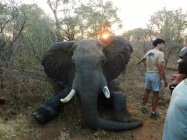 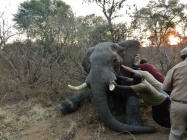 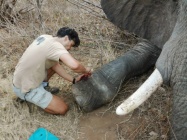
The next hour is a blur of decision weighing and physical activity. All too aware that the longer the elephant is in a sternal position the more risk it is to him, Keith frantically chainsaws through the dense mopane wood to clear a bed for the elephant. At one point he has to crawl under the great beast’s tusks to cut away two branches between his forelegs that are locking his body in place. When manpower fails to push the elephant over, Nic has to cut a path for the land rover to come in. Keith and Lisa meanwhile monitor the anaesthetic and start the difficult task of trying to remove the wire snare from the elephant’s front foot, which is now embedded 10cm deep around his metacarpal bones. The elephant flinches and flaps his ears. Despite him being narcotised his right eye seems to be watching everything we are doing. Local anaesthetic is infiltrated into the wounds. The wire can be felt at the tips of the vets’ fingers but getting wire cutters in that deep is another story. Doubts arise as to whether it’s possible to fully remove the snare. The incisions have to be widened, and blood flows freely into the surgical field. After 20 minutes, the loop of the snare is cut and a 6cm piece of thick steel wire extracted. Daylight is failing. As the sun sinks below the horizon the land rover is finally in a position to pull him by ropes onto his side. Phew! The stats stabilise on the pulse oximeter giving the vets a bit more breathing time. Blood samples are taken and ultra-long acting anti-biotics and painkillers are administered. It is pitch black now, apart from the land rover headlights and a few cell phone torches. The vets begin to think this snare will defeat them. At least the loop was cut, the steel won’t continue to tighten. But they know at the back of their minds the wire will continue to act as a foreign body and encourage infection. “Let’s make one last attempt from the back incision, then if that fails, we’ll wake him up”.
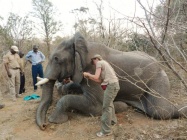 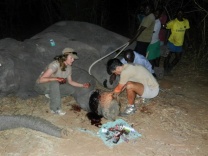 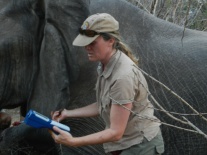
At long last, Keith triumphantly utters “got you, you bitch!”, as the 60cm piece of wire comes out intact from the caudal incision. Elation washes over everyone present!! The stress has all been worth it for this moment. Without delay, the wound is cleaned and anti-biotic impregnated beads are inserted into the incisions for sustained release. The wounds are doused with wound spray and Exit, and by the time Lisa reverses the animal, all personnel are packed like sardines onto the back of the land rover. In the pitch blackness we can just make out the outline of the elephant lumbering to its feet from ten meters away. We make a hasty retreat.
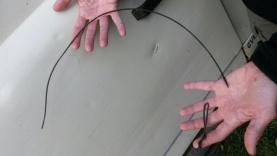
Another Injured Elephant Needing Help
Today was deeply satisfying. Last weekend at Matusadona, the day ended in frustration. Having travelled the 400km car journey, plus hour boat ride over to the remote station to treat three elephants, only one of the three elephants was located because Parks trackers had to be deployed after poachers after gunshots were heard and an elephant was found dead. The elephant we treated was reported to have a swollen eye. Due to the scarcity of vehicles, we walked into this one by foot with Andries and Marney from KAWFT, and Ashley the Tashinga ecologist and a ranger, and had an equally hair-raising time avoiding other adult bulls in the area. Again the elephant went down in a bad position - on his side with his head facing downhill, and surrounded by trees. The eye that we needed to examine and treat was against the ground, so we could not make a diagnosis. The trees meant it was impossible to turn him. We did notice an abscess on his uppermost cheek and his breathing was stertorous indicating a sinusitis. On our list of differential diagnoses for this elephant is a possible A-K bullet hole through his cheek and trunk. This elephant was obviously fairly sick and he started to develop respiratory problems under the anaesthetic necessitating us to reverse him within five minutes of getting to him. After reversal he took an additional 30 minutes – and more doses of reversal - to stand, which is very unusual. He was administered long acting penicillin just before reversal and we will monitor his progress as he seems to hang around Tashinga HQ.
 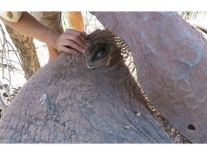 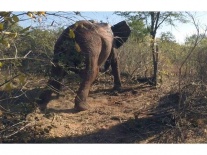
These incidents serve to emphasise that in thickly wooded terrain it would definitely be preferable to immobilise these injured elephants with a helicopter, for the safety of both personnel and elephants. With a helicopter, there is no chance of losing sight of the elephant after darting, and he could be herded to an open area so that he does not go down in an awkward position. It costs $850 per hour for the helicopter. We have also realised the potential of a drone for keeping sight of the elephants after darting, and would appeal to the public for funding for this. They cost in the region of $3000. Additionally AWARE would like to raise funds for satellite collars so that the animals whose injuries are severe can be tracked and re-treated, and their progress followed. Satellite collars are $3500 each.
Keith and Lisa do not derive a salary from AWARE, and perform this work for free. AWARE needs continued funding and support to help these injured animals, reports of which are getting more numerous.
Please support our work - through Paypal, use the details on our website or contact tracey@awaretrust.org if you wish to make a donation or require bank details.
AWARE Thanks You All
Our sincere thanks to Jenny Nobes at Rhino Camp, Matusadona for putting us up, feeding us, and allowing us the use of their land rover; Henry of MAPP for vehicle support; Nic and Iona Coetzee for putting us up and feeding us at Chirundu. Thanks to Debbie Ottman of KAWFT for arranging the logistics for Matusadona, and Andries Scholtz and Marney Kloppers for the back-up. Also to Bob and Cher of Marineland for giving us discounted boat fare across Lake Kariba. Thanks to Redan for their continued fuel support. Thanks to Abaxis for loan of their blood testing equipment. Thanks to Parks and Wildlife Management Authority for their support with rangers.THANK YOU Greg Michel and Babette Grobler for taking up AWARE's monthly challenge, which was posted on May 26. Also to Therese Paterson and Daniela Tanner for their general contribution.
AWARE's Fundraising Golf Day
To all the companies and individuals who sponsored, supported and physically helped at the very successful AWARE Fundraising Golf Day on 5th June, our very grateful thanks for the excellent funds raised. You will all see from this newsletter exactly how these funds have already helped with AWARE's Wildlife Rescue Operations and we are most grateful to each of you for your incredible support. Thank you all for making the day so successful - and such fun! We salute you all!
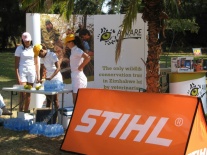 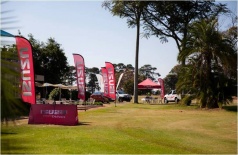 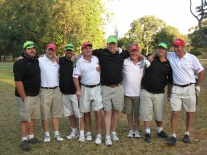
 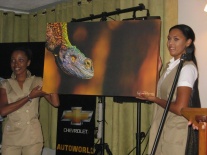 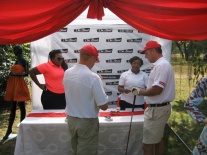 
Our sincere thanks to all those below and our apologies if we have inadvertently left anyone out:
ACDC Natural Air, Andy Lowe Photography, Atlas & LRSS, Autoworld, Big Sky, Cheeseman, David Cruttenden, Di & Gary Meller, Di & Staff Wingate Golf Club, Eezi Pool, Glass Creations, Laser Audio Vision & HRIB Insurance, Lorraine & The Cartridge Company, Mike Wedlock, M. Lloyd, Model Management International, Carole, Oliver and the Wales-Smith Family, Patrick Mavros, Powerspeed, Revolta's Roots, Rimov & Clint Skinner, Sawpower & STIHL, Stable Winery, Sue Hawthorn & Lynette Riley, Swift, Toyota Zimbabwe, Trotters & Bruce McLauchlan, Victoria Moor, Yolana Investments & Chic Street, YoMilk, Zimbrella & Home, ZOL and all the participating teams.
|